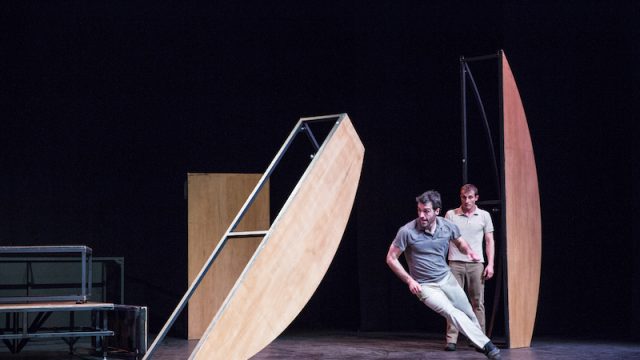Review from: artsdepot, London; 28th October 2018

With a company of four male performers, inTarsi seeks to tenderly examine ‘the strange beast that is the human being’ through a blend of acrobatics, contemporary dance and physical theatre. The exploratory piece from the award-winning Spanish Compaña de Circo “eia” is directed by the four performers (Armando Rabanera Muro, Fabio Nicolini, Fabrizio Giannini, Manel Rosés Moretó) and Jordi Aspa, with choreography from Michelle Man, and has been produced in their UK tour by Pitchbend Productions. The show uses group work and visual moments to challenge itself and its audience by purposely eschewing a traditional celebration of tricks and stunts, in a surreal non-linear hyperbole.

The show begins with the men doing small actions on stage as the doors of the theatre open, so there is no distinct ‘start’. Movements are downplayed and humanised to the point where they no longer feel dangerous. There are no set characters as the roles shift and change. So, whilst these theatrical techniques are interesting, I find it difficult to care about the performers. Are they personifications? Or merely iterations of male humans, without the individuality of being people? There are moments of happiness, of power games, of subjugation, of flirtatiousness, but they exist as moments only, skimming the surface of different emotions and human connections. At no point, as the acrobats dive and fall, do we tumble deeply into any of these feelings; we never get to pure joy, or abject despair, uncontrollable lust, or savage cruelty. If this is humanness, then it is a fairly beige experience.

Some of the episodes work very well. One of my favourites is a section where one of the anonymous acrobats calls out a long sequence of words – “hands, feet, hands, hands, fingers” etc – then showing a series of flips and handstands that correspond exactly to the words, which are repeated back to him. It serves to disassociate the action from language so that it can be seen anew. It demonstrates that circus is visual in essence and, when stripped down linguistically to its elements, lacks meaning. It’s also genuinely funny and could easily be extended into a solo cabaret act successfully.

These vignettes take place on an abstract piece of staging that can be taken apart and rearranged in endless new forms. A round edge becomes a teeterboard. Two large pieces are stood upright as pillars dominating the space. And smaller sections are flipped and spun as performers run, jump and slide across them. At other points, the set is taken apart and put back together in new forms that the performers can move against in interesting ways. Much of the acrobatics is impressive. However, as the show goes on, the different sections feel unconnected and, if the order of events were to be randomly generated, I’m not sure if it would be experienced any differently.
inTarsi fits within a growing branch of contemporary circus that has a number of tropes which are becoming predictable: norm-core clothing where the cast look like extras from a 90’s GAP advert, extensive use of silence, and extended moments of performers falling elaborately in acrobatic positions. These are modes of expression for looking at humanness through circus that, by their very ordinariness, scream ‘take me seriously as an art-form’.

The most interesting part of inTarsi, to me, is the continual inversions of masculinity that take place as the action unfolds. Towards the end of the show, one of the acrobats is stripped near naked. He poses and moves his chest and stomach, turning a brash moment into one of intense vulnerability. It’s strange and unusual and captivating. Male circus bodies are often held as society’s ideal expectation of a man, so to distort and look at this from a different perspective is disarming.

This may all sound too intellectual, but inTarsi claims that space for itself. At the artsdepot in North Finchley at 2pm on a Sunday, the majority of the audience are families with young children. Whilst it is good to try and elevate the experience children have of theatre, clearly many struggle to sit still for the full hour and concentrate, with none of the sort of punctuation that is often provided in more classic circus by “ta-dah” jazz hands moments after tricks, for example. This is not really a show that makes sense for young children, and this unfortunate mismatch of show to audience in a fairly small space means that even the stronger moments feel flattened.

Until recent decades, circus was almost exclusively regarded as mass market entertainment, so the subject matter of inTarsi feels like new – though increasingly explored – territory. Art, music and dance have been exploring this sort of humanness for thousands of years though, so we need shows like inTarsi, to keep pushing boundaries. Although it would be good if circus could go further as an art-form and try to explore something more specific to the human experience than simply ‘humanness’ itself. There are clever elements and ideas, and the performers work hard and are clearly skilled, but at no point in this show do I feel moments of wonder or awe. In striving to touch the everyday of reality, inTarsi ultimately hides the exceptionality inherent within circus.
.




